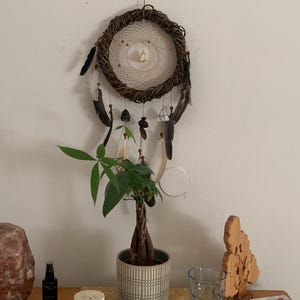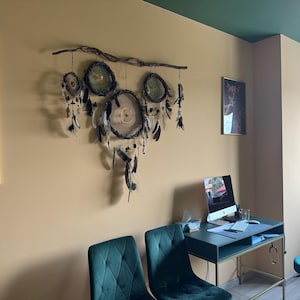🌙 Where to Hang Your Dreamcatcher According to Vastu — and How to Care for It

One of the questions we often receive at ArMoniZar is about the ideal place to hang a dreamcatcher inside the home — especially from those who also follow the principles of Vastu Shastra, the ancient Indian science of balance between space and natural energies.
Recently, a reader wrote to us:
“Hello Namaste..!
I hang my Dream Catcher in my room on the 1st floor window, on the north-east side, along with all the plants. Exactly below is the entrance of the house, and at night we close the window, which has glass. Can you guide me if that is correct according to Vastu?
Or please suggest the wall where I can hang it for the best benefits. Also, suggest how to take care of the Dreamcatcher when it comes to cleaning.
Thank you..!”
— Deepak Mestry.
We loved this question, because it reflects a beautiful intention: to harmonize the home with awareness and respect for energy and the elements. 🌿✨
🪶 1. The Best Direction According to Vastu
In Vastu Shastra, the northeast (called Ishanya) is considered an auspicious direction associated with the spiritual flow and the element of water. It is the ideal place for sacred objects, plants, and elements that promote peace, purification, and clarity of mind — like a dreamcatcher.
👉 If your window faces northeast, that’s a wonderful direction.
It supports deep rest, intuition, and mental clarity. Just make sure the area stays clean, bright, and not overly crowded with plants or moisture.
🪞 2. About the Window Glass
Ancient Vastu texts recommend that windows in the northeast allow clear or lightly tinted light, symbolizing purity and expansion.
If possible, choose glass that is transparent or slightly bluish, as these tones enhance the gentle morning sunlight — the most beneficial energy for spiritual renewal and rest.
Avoid dark or heavily tinted glass, which can block the subtle flow of positive energy (prana).
If you already have standard glass, that’s perfectly fine: you can simply hang your dreamcatcher right in front of the window, letting the crystals and feathers filter the morning light naturally. 🌞

🏡 3. If You Prefer to Hang It on a Wall
If your window doesn’t get much light, or the energy feels “heavy” because the main entrance is right below, you can move your dreamcatcher to one of these walls:
-
East: encourages clarity, new beginnings, and mental focus.
-
North: ideal for peace, emotional balance, and protection.
-
West: good if your main intention is deep dreaming and spiritual connection during sleep.
Avoid the south or southwest if your purpose is restful sleep or dream protection, as those directions are more active and material in energy.


💎 4. How to Clean and Care for Your Dreamcatcher
Just like any sacred handmade piece created from natural materials, your dreamcatcher also absorbs and transforms energy. Keeping it clean and refreshed is essential.
💨 Physical cleaning:
Gently remove dust with your hands, a soft feather duster, or a clean, dry brush (our favorite method!). Avoid water if it has natural feathers.
You can also pass a bit of smudging smoke (sage, palo santo, or your preferred incense) around it to refresh its energy.
☀️ Energetic cleaning:
Once a month — or after an intense dream — hang it in the gentle morning sunlight or under the full moonlight for a few minutes.
Both lights help to purify the crystals and renew the flow of protection.
🌬️ Intention:
While cleaning, take a moment to thank the piece for guarding your dreams and the energy of your home. The dreamcatcher’s power is also activated through your own gratitude and connection with it.
🌺 5. A Reminder from ArMoniZar
Every home has its own vibration. The perfect place for your dreamcatcher will always be where the energy feels alive and harmonious.
If, when you look at it, you feel calm, inspired, and protected — then it’s already in the right place.
Both Native American and Vastu traditions remind us of a shared truth:
The harmony of our soul is reflected in the spaces we live in.

✨ Final tip:
You can place a small quartz or amethyst nearby to enhance the energy cleansing of the area and keep the dreamcatcher’s field pure and luminous.
📚 References for the Curious
For readers who love to explore the original Vastu foundations, here are some classical treatises that inspired the principles shared above:
-
Mānasāra — one of the earliest Sanskrit texts on architecture and spatial harmony.
-
Mayāmātam — a key treatise of the Vastu and Shilpa Shastra traditions.
-
Samarāṅgaṇa Sūtradhāra — attributed to King Bhoja (11th century), detailing architectural energy and orientation.
-
Aparājitapṛcchā — a 12th-century text covering sacred geometry and design philosophy.



